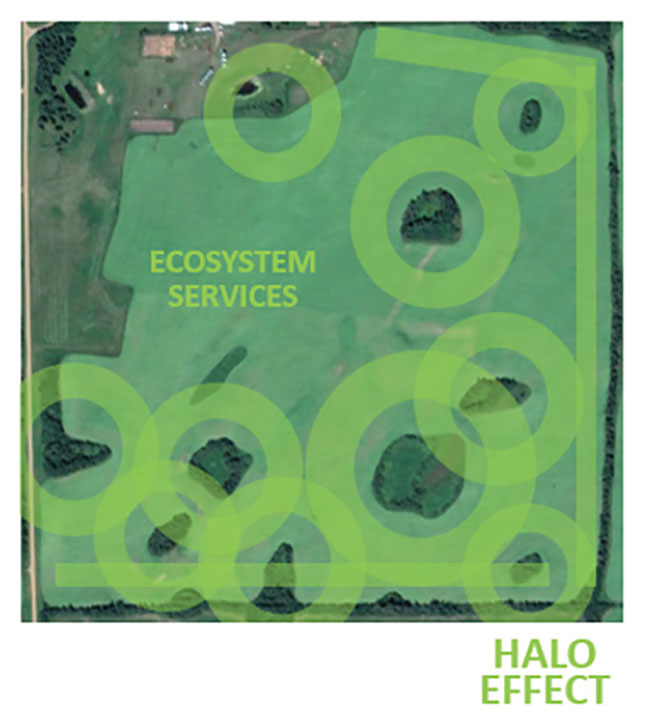
Features
Agronomy
Landscape complexity can boost yields
Fields bordered by “messy” non-cropped areas see a host of ecosystem benefits.
September 30, 2023 By Julienne Isaacs
 Diagram illustrating the “halo effect,” where yield is highest a short distance from a field boundary into the field, but levels off or dips toward the field centre.
Photo courtesy of Paul Galpern.
Diagram illustrating the “halo effect,” where yield is highest a short distance from a field boundary into the field, but levels off or dips toward the field centre.
Photo courtesy of Paul Galpern. “We’re really interested in messy fields,” says Paul Galpern, an associate professor in the department of biological sciences at the University of Calgary.
By “messy fields,” Galpern isn’t referring to crop residue or field trash. He’s talking about fields that contain or are bordered by natural, non-cropped areas – wetlands, shelterbelts, hedgerows, fencerows or patches of trees. These natural areas make farm landscapes more complex. From a producer’s point-of-view, maintaining or adding complexity in the form of wetlands or tree patches could seem a tactical negative if he or she is forced to drive around them.
But, Galpern and his research associate, Samuel Robinson, have new evidence that, in fact, landscape complexity can boost yields by adding a host of ecosystem services to neighbouring cropland.
“When we look to farms in Europe or Asia, farm fields where there’s more landscape complexity, those fields tend to have more insects in them that [provide benefits], like bees, pollinators or natural enemies of pest insects,” says Galpern. “Under certain circumstances, those fields might have higher-yielding crops, so we wanted to ask that question within the Canadian Prairies.”
Along with their colleague Lan Nguyen at the University of Calgary, Galpern and Robinson recently published a study that used satellite imagery and precision agriculture data to show that fields with higher landscape complexity had higher mean yields.
Robinson says the researchers collected combine harvester yield data from eight canola fields in the centre of a 100-km-by-100-km cropping region in the Vermilion River district of Alberta; they used the precision yield dataset from those eight fields to build a yield mapping model for the surrounding region.
They described the landscape complexity of those eight canola fields and compared this information to satellite imagery to get a sense of how to identify non-crop areas in photos taken from space. They then used predictions from the model to estimate how much yields varied with landscape complexity over the study’s entire area.
Robinson carefully analyzed the non-crop areas within the eight canola fields. “I looked at the composition of the edge of the fields. Most fields are bounded by a grassy strip or a road or set of trees, or by another field,” explains Robinson. “I was interested in how those edges affect the yield. In general, we have a dip at the edge of the crop.”
That dip at field edges is known as the “edge effect;” it refers to the yield dip producers can see in a field’s outer rows, due to lack of moisture or compaction.
There are other effects to look for near field boundaries, though: one is the “halo effect,” where yield is highest a short distance from a field boundary into the field, but levels off or dips toward the field centre. Another is the “spillover effect,” says Galpern, in which the benefits of increased beneficial insect populations in non-crop areas bordering fields “spill over” into the crop and boost yields a short distance from those edges.
Results
Nguyen, Robinson and Galpern found there was indeed a slight positive yield effect of non-crop marginal habitats on mean canola yield.
But, they also found evidence that canola fields that were surrounded mostly by non-crop covers had slightly lower mean yields, perhaps partly due to the edge effect, Robinson says. Canola fields that were mostly surrounded by other crop fields also saw lower yields, perhaps due to the lack of ecosystem services, like pollination and pest control, provided by non-crop habitat.
Why did fields with more landscape complexity see higher yields in general? There are several potential reasons, says Robinson. “Crops benefit from natural enemies, beetles or spiders, that live in messy areas. The services of these pest control insects are contributing to the yield. In crops like canola, with flowers visited by insects, there may also be a small yield boost,” he says.
There are also abiotic effects, he adds: shelterbelts and hedgerows can provide some temperature control and reduce wind speeds. They could also provide a supply of carbon and nutrients via leaf litter.
“The thing we’re increasingly working to convince farmers of is if we’re using large scale data we can learn so much more,” he says. “There are opportunities for learning about these larger-scale patterns, and then looking at individual farms,” says Robinson. “I think there are opportunities at both scales.”